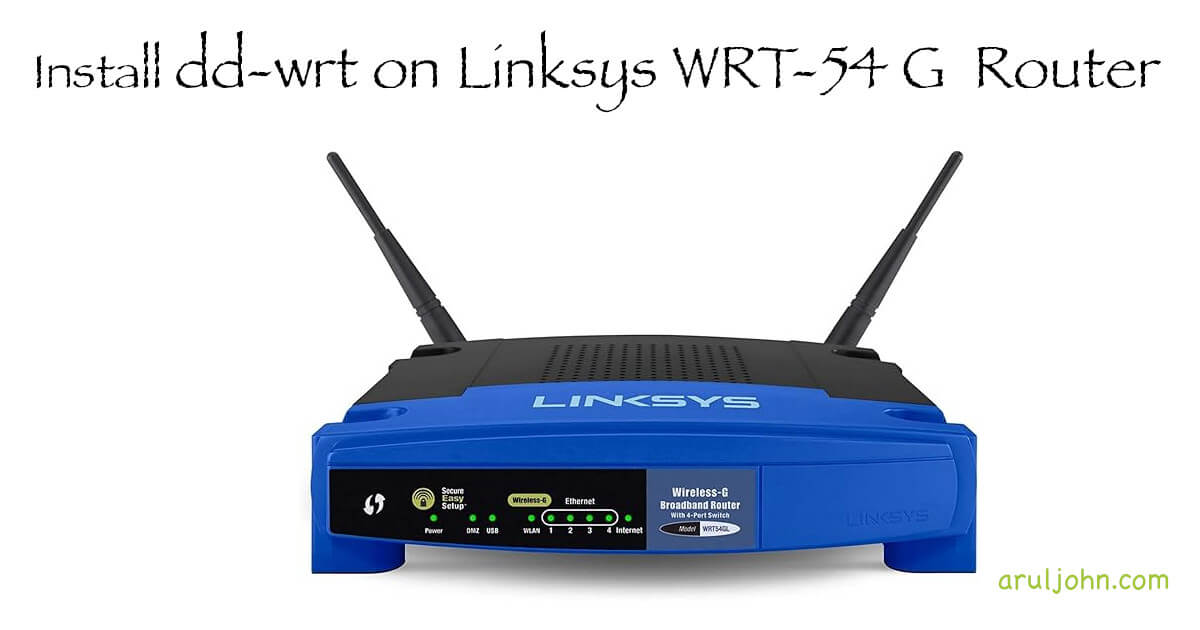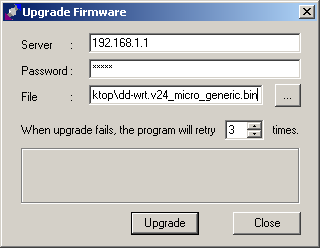This article was written in 2009. A lot has changed since then, and I left it here for historical purposes. Newer blog posts are coming up.
 How to install dd-wrt firmware on Linksys WRT54G wifi router
How to install dd-wrt firmware on Linksys WRT54G wifi router
I have a Linksys WRT54G Wireless-G router that runs Linux.
The great thing about this router is that it is easily customisable and highly configurable after uploading third-party firmwares like DD-WRT, Tomato and OpenWRT. You can even write your own scripts and upload them to the router.
At the moment, I have a client-bridge setup with the Linksys WRT54G router as the primary router and a Buffalo WHR-G125 as a secondary router using the same SSID.
DISCLAIMER: Anything you do below this line carries a certain amount of risk and there is always a possibility of bricking your router! I have only detailed the steps I took to install DD-WRT on my router and several other routers. Note that this is NOT an official DD-WRT site.
**Whatever you do is done AT YOUR OWN RISK. I AM NOT RESPONSIBLE for what happens to your router. If you are willing to risk your router with the firmware change, read on, or else look somewhere else.
Table of Contents
- Serial numbers of Linksys WRT54G and WRT54GL routers
- Installing DD-WRT in Linksys WRT54G versions 1.0, 1.1, 2.0, 2.1, 3.0, 4.0
- Installing DD-WRT in Linksys WRT54G versions 5.0, 5.1, 6.0, 8.0
- Configuring DD-WRT
- Shell commands
- Display CPU information of your router
- Display time the router has been up
- Display Linux version
- Scan for wireless networks nearby
Serial numbers of Linksys WRT54G and WRT54GL routers
Before buying the routers, you need to check the serial numbers so you'll know the version.
Here's how you detect the version of Linux routers from the carton. The serial number of the router should end in this
| Serial | Version | Version/Notes |
|---|---|---|
| CDF0, CDF1 | WRT54G 1.0 | DD-WRT 23 SP2 standard |
| CDF2, CDF3 | WRT54G 1.1 | DD-WRT 23 SP2 standard |
| CDF5 | WRT54G 2.0 | DD-WRT 23 SP2 standard |
| CDF7 | WRT54G 2.2 | DD-WRT 23 SP2 standard |
| CDF8 | WRT54G 3.0 | DD-WRT 23 SP2 standard |
| CDF9 | WRT54G 3.1 | DD-WRT 23 SP2 standard |
| CDFA | WRT54G 4.0 | DD-WRT 23 SP2 standard |
| CDFB | WRT54G 5.0 | DD-WRT 23 SP2 micro |
| CDFC | WRT54G 5.1 | DD-WRT 23 SP2 micro |
| CDFD | WRT54G 6.0 | DD-WRT 23 SP2 micro |
| WRT54G 7.0 | **DO NOT BUY THIS, it is not supported by DD-WRT** |
Installing DD-WRT in Linksys WRT54G versions 1.0, 1.1, 2.0, 2.1, 3.0, 4.0
- Download the mini version of DD-WRT (dd-wrt.v23_sp2_mini.zip)
- Log on to your Linksys in the admin mode. Click on http://192.168.1.1.
- Go to Administration → Firmware Upgrade and upload the DD-WRT mini firmware. Do NOT interrupt the process or your router will be toast! (The mini version was uploaded first because the default Linksys firmware contains insufficient space in the nvram, so we have to blow it up with the mini before the std.)
- Now, lets upload the real standard version. Download and unzip the standard version (dd-wrt.v23_sp2_standard.zip). You will need to use corresponding .bin file, for example, if you have a WRT54G, you would be using the firmware dd-wrt.v23_wrt54g.bin for the upgrade.
- You should get a message like "Upgrade successful".
- Check if DD-WRT standard version 23 is installed by going to http://192.168.1.1.
If everything is alright, you may log in now. The default username is root and default password is the same password that you used before.
Installing DD-WRT in Linksys WRT54G versions 5.0, 5.1, 6.0, 8.0
- First download VxWorks Killer {vxworkskillerGv8-v3.bin}.
- Download DD-WRT micro generic v24 RC6.2 {dd-wrt.v24_mini_generic.bin}.
- Download TFTP2 {tftp2.exe}.
-
Reset the router to factory defaults
-
Login to the router interface at http://192.168.1.1
-
Go to Administration → Factory Defaults and reset it
- Update your firmware with VxWorks Killer
- Go to Administration → Firmware Upgrade
- Select vxworkskillerGv8-v3.bin and click on the Upgrade button.
- Wait for a couple of minutes till it resets and then move to the next step.
- Upgrade to dd-wrt micro
- Double-click on tftp2.exe and enter these details. Server: 192.168.1.1 Password: admin File: path to dd-wrt.v24_micro_generic.bin
- Click on Upgrade

- Wait for it to upgrade. If you get this message Upgrade are successful login to the new DD-WRT firmware.
If everything is alright, you may log in now. The default username is root and default password is admin.
Configuring DD-WRT
Enable SSH
Go to Administration » Management and select Enable for SSH Management Set any other settings that you would like. Then, click on the Save Settings button.
Increase transmit power
The default transmit power is only 28 mW! You can increase it upto more than 200 mW, but lets keep it below 70.
Go to Wireless » Advanced Settings and enter a decent value (below 70) for Xmit Power. Federal regulations prevent increasing your wireless signal beyond a point because the signals may kick out other signals (your poor neighbours').
Shell commands
DD-WRT comes with a built-in shell called ash. Lets play around with the commands.
Connect to your router via SSH using PuTTY (if you use Windows) or any remote terminal software. Login as "root" and type in your password.
Display CPU information of your router
~ # cat /proc/cpuinfo system type : Broadcom BCM4712 chip rev 1 processor : 0 cpu model : BCM3302 V0.7 BogoMIPS : 199.06 wait instruction : no microsecond timers : yes tlb_entries : 32 extra interrupt vector : no hardware watchpoint : no VCED exceptions : not available VCEI exceptions : not available
Display time the router has been up
~ # uptime 08:49:30 up 7 days, 11:56, load average: 0.03, 0.02, 0.00
Display Linux version
~ # cat /proc/version Linux version 2.4.33-pre2 (root@linux) (gcc version 4.1.0) #775 Tue May 16 20:13:17 CEST 2006
Scan for wireless networks nearby
~ # wl ap 0 ~ # wl scanresults ~ # wl ap 1
Related Posts
If you have any questions, please contact me at arulbOsutkNiqlzziyties@gNqmaizl.bkcom. You can also post questions in our Facebook group. Thank you.